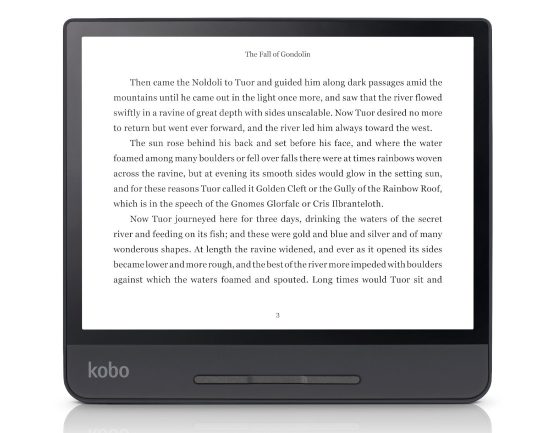This year color E Ink has made a resurgence with the recent release of the Poke2 Color and PocketBook Color, but whatever happened to the advancement of flexible E Ink screens?
The Kobo Forma was the first and only ebook reader under 10-inches to feature a flexible E Ink Mobius screen, and it was released back in October 2018.
Mobius screens started out on larger 10.3-inch and 13.3-inch ereaders because the larger screens were easier to crack when made with a traditional glass backplane. Kobo was the first to offer an ereader with a Mobius screen on a smaller 8-inch device.
Mobius screens are superior to traditional glass-backed E Ink screens because they use flexible plastic-based backing instead of glass, so they are lighter and more durable, and it’s still the same E Ink on front so there is no downside.
This Kobo Forma twist test demonstrates just how durable Mobius screens are, so why are glass backplanes still being used at all?
A flexible screen is far more useful than waterproofing, but you’ll have no trouble finding waterproof ebook readers these days. I’ve literally never heard of anyone breaking an ebook reader by getting it wet, but a cracked screen is one of the leading causes of breakages.
It’s surprisingly easy to crack an E Ink screen. Tossing an ebook reader into a bag without a cover or simply sitting on an ereader that’s in your back pocket can easily break the thin glass backplane.
Once the screen is cracked the device is no longer usable and there’s no fixing a cracked E Ink screen. In most cases it’s more trouble and expense than it’s worth to replace an E Ink screen—you’re better off just buying a new ereader or something refurbished for barely more than a replacement screen sells for new.
Hopefully more ebook readers will start using flexible E Ink screens in the future. With a proper casing design they are virtually indestructible, not to mention lighter. It’s surprising no other companies have used the Kobo Forma’s screen yet. After Kobo released the Kobo Aura One, the first ereader with a 7.8-inch E Ink screen, several other models started coming out with 7.8-inch screens too.


I guess that plastic somehow connotes a less premium device. I actually had (very)slight concerns about the plastic screen and body of the Kobo Forma, before buying; now after owning the Forma, there are no concerns. I see Mobius screens as necessary for larger devices. The only quality flaw of the Forma,IMO, is the light strip visible on the handle side.
The advantages in lower weight and durability are real. Hopefully we will see a couple larger devices make use of Mobius this year. There’s actually no reason not to adopt this screen technology on the smaller Kindle Paperwhite or Kobo Clara.
I wonder
Lets try that again ….
I wonder if the manufacturers, or eInk, have a lot of remaining stock of glass screens that makes them significantly cheaper to use. Except for attempts at color, I can’t recall any change in the screen technology used in new reader for quite a long time. All the changes have been to layers over the base eInk screen, the touch and/or lighting layers have changed, but we have been on the eInk Carta HD since 2014.
It is also possible that it is harder to manufacture the Mobius screens. Perhaps it is harder to successfully lay down the micro-capsule layer on the flexible substrate, making Mobius more expensive to manufacture. We don’t see many smart phones or tablets with flexible LCD displays yet either. There must be some reason behind this, even if it is a simple as building a more durable device is not in the manufacturer’s best interest because it we break a device, we buy a new one.
In any case, let’s hope we quickly get past whatever the issue is and we start seeing more Mobius based devices in smaller sizes. I suspect is Amazon came out with a 6″ to 8″ device based on Mobius, we would see a flood of devices changing over.
Nathan,
I was just looking at the comments on your review of the Boox Nova2. In the comments, vicente asks if the screen is flexible. You reply that it is the same screen as “all previous 10.3 models”. Does the Nova2 have a Mobius screen, making it the second device under 10″ with a flexible screen? Or, perhaps you were confusing it with the Note2?
(Onyx’s web site says it is a Carta screen.)
For some reason I thought the comment was referring to the Note2. I went back and changed it since the Nova uses a Carta screen.
My aunt dropped her Kindle (non-waterproof) into the tub a few years ago, ruining it.
I like to read in the tub or near water myself, so I appreciate the waterproofing.
Not that I’m against flexible screens. Just saying waterproofing is a thing for a reason.
The Forma is waterproof. I don’t see what your point is. It’s not either/or.
The point is likely referring to me saying I’d never heard of anyone breaking an e-reader by getting it wet.
I thought Onyx Boox used Mobius screen their devices?
Source: https://medium.com/@OnyxBoox/how-much-do-you-know-about-e-ink-screens-nothing-9a7a76b30e2c
Larger devices, yes, but their smaller devices use Carta screens. Whoever wrote that article didn’t know what they were talking about.